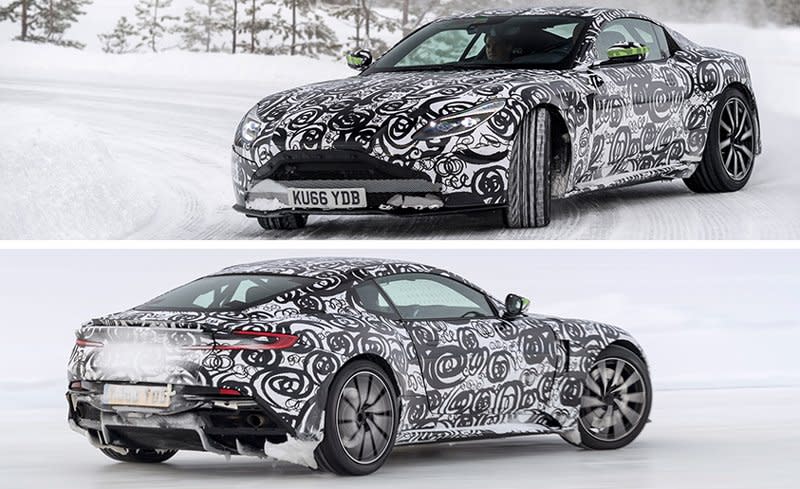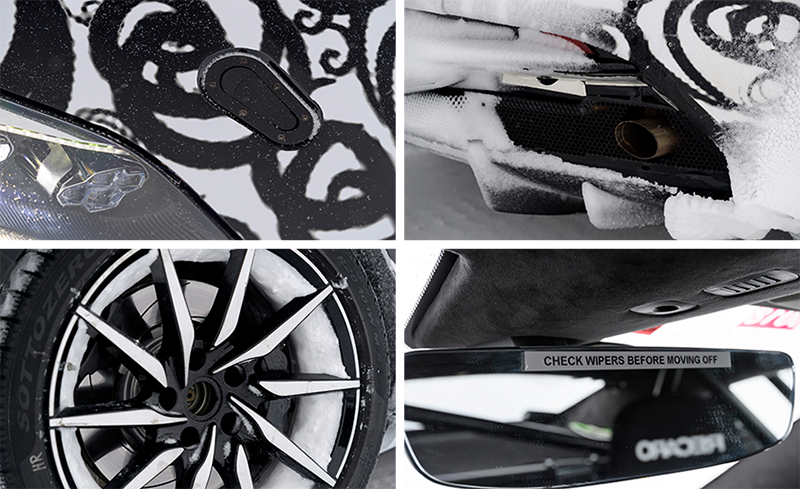2019 Aston Martin Vantage

Near the Arctic Circle, Sweden — A snarl rips in the distance; it’s morning and the sound must mean the engineers have arrived. Pulling back the hotel room’s blackout curtain—a necessity for summer months here when the sun, like a toddler, protests ever going to bed—reveals a soft Arctic light washing over desolate stretches of frozen earth and deep forest. But there’s no sign of the car we’re here to meet, the long-awaited next generation of Aston Martin’s best-selling sports car, the 2019 Vantage. We’ve been promised a ride after breakfast and a technical briefing.
Leaving our lodgings, fresh snowfall silences our steps except when we’re on the plowed road, where our shoes crunch on compacted snow until we slip on a rink-smooth patch of ice. In just 20 feet of walking, we’ve encountered all the conditions that make this an ideal testing ground for verifying a car’s winter chops.

In the technical center we’re debriefed on the new Vantage, a two-door, two-seat sports car fitted with an Astonized version of Mercedes-AMG’s twin-turbo 4.0-liter V-8 and a ZF-sourced eight-speed automatic transaxle. A seven-speed manual transmission is planned to follow sometime after the launch. Regardless of how the gears are shifted, there’s 503 horsepower and 505 lb-ft of torque on tap in a car that’s 10.8 inches shorter and significantly lighter than the version of the DB11 with this same engine. This car’s iteration of Aston Martin’s bonded-aluminum chassis is similar to the DB11’s, but approximately 70 percent of the parts are specific to the Vantage.
There are three modes for driving and also for the adaptive suspension damping: Sport, Sport+, and Track. Gone is the DB11’s GT mode, which speaks to what the company wants this car to be. Matt Becker, Aston Martin’s chief vehicle attributes engineer, sums up his main job for the Vantage: to “make it drive like it looks.”
Disguised as a DB11
Clad in black-and-white camouflage wrap, the prototype looks strikingly similar to a DB11. “That’s intentional,” Becker says. “Fundamentally what we’ve done is make it look as DB11 as possible for now, to keep people like yourself—the journalists—at bay. But it has a [mechanically] representative underbody. In terms of how far along we are in the journey, this [prototype] is about 50 to 60 percent.”

The details are there as we allow our eyes to travel over the surfaces, and now the Vantage has recently been fully revealed in official photographs. The car is about the same width as the DB11 and seems twice as wide as more pedestrian sports cars. Vents on the fenders serve both functional and aesthetic purposes, while the lip spoiler on the trunk adds even more visual presence in addition to providing downforce.
Slide In and Go Slidin’
“Right, shall we go for a spin?” Becker says. While latching the test mule’s racing bucket seat we’re told that the production Vantage will boast sport seats for greater lateral support (as well as normal seatbelts). Most of this car’s cabin—as is to be expected with an early prototype—is lifted straight out of the DB11. The elegance and finery, the sporty details we’ve come to expect from Aston Martin, will come later. For now, it’s about getting the core dynamics right.
The car fires up with a loud growl that ricochets off of the garage walls. We’re adjacent to a sort of winter-car-testing Disneyland. Several OEMs use this facility, and it appears BMW also is hard at work today. Camouflaged future models drive in various directions, the whole scene made extra surreal due to a cocktail of jet lag, time change, and anticipation.

The first order of the day is a split-mu exercise, performed by climbing a steep hill with the left wheels on asphalt while the rights ride on ice, “split mu” in engineer-speak. The traction- and stability-control algorithms demonstrate just how advanced this technology has become as we smoothly glide up the hill. “Now, let’s try it with systems off. We have to develop the car with the systems on and off,” Becker says. Although not with the same effortless grace, the car is able to drive up with only a small amount of effort.
Next we’re on to an elaborate ice track with elevation changes and slow and fast corners. Our first lap is done with the stability-control system turned on. Glances in the side mirror reveal a consistent spray of snow flying from beneath the tires in little white bursts. Predictably, once the stability control is turned off, we’re swooshing sideways into turns, Becker occasionally massaging the throttle to maintain a drift and execute proper opposite-lock driving for the majority of the lap. “One of the big things we worked on was ensuring less body roll,” Becker says. Additional torsional stiffness works to aid this cause, but it’s a holistic approach using several of the elements in the Vantage’s toolbox.

“[The] Vantage is about driving. It’s all about driving,” Becker emphasizes. “And that doesn’t mean it needs to be uncomfortable, it just means we have a huge dynamic spectrum, with the amount of tools in the car.” The goal is to connect with, respond to, and reward drivers, and the automaker’s first ever electronically controlled limited-slip rear differential makes a big contribution.
“What that allows us to do is vary the amount of torque going across the rear axle, which makes the car [feel] very short, very agile. And with tricks like [brake-based] dynamic torque vectoring—because the Vantage can open up the rear differential—it’s like putting a pole in the ground when you’re skiing. So, the car will rotate very quickly.”
Aston benchmarked the Porsche 911 and the McLaren 570S, and one thing Becker was impressed with on the 911 was how the front axle performed. “It has this feeling that the more you turn the steering wheel, the more grip you’re gaining.” Applying that to the Vantage came down to three main elements.

“Some of that is fundamentally down to the suspension geometry, and that has to be correct. But also tire development. We switched from the DB11’s Bridgestone tires to Pirelli as our technical supplier. We’re familiar with the P Zeros, and I really like the experience of that tire. And they’ve worked with us to formulate and create a compound of that tire specifically for this car.”
The third element boosting front-end response and an overall balanced feel is aerodynamics. According to Becker, whereas the DB11 has a little bit of lift at the front and downforce at the rear, the Vantage benefits from downforce both front and rear.
On to Public Roads
Mark Barron, one of the Vantage’s primary engineers, takes the wheel and we head to one of his oft-used testing roads.
“Locals drive on these very roads, so this is very much real-world everyday conditions for those that live here. It’s great for testing traction and stability, but not for tuning. That’s why we like the lake, the conditions are more stable than on a road like this, [and consistency] is what you really need for tuning.” As we climb a sizable hill that Barron assures will provide a worthy vista at the top, we can hear the car in full song, sounding glorious, throaty, and happy. We ask him to elaborate on tuning the acoustics.

“We have our new controller, and the algorithms that go into that are endless. But it’s about calibrating the engine and gearshifts as they should be for [the] Vantage, and how that should sound as well.” Much of the sound will get tweaked in the later stages of development, but we can confirm the starting point was already pretty spectacular.
On our final push up the hill, Barron points out that the steering assist is variable, effort being adjusted instantly based on the driving mode, vehicle speed, and a number of other factors. “There’s a lot of dialogue, communication between the driver and car, but it’s still a fairly approachable car.”

When we reach the top of the hill the view—as promised—was worth the trip. The morning cloud cover has burned off, the low sun beams across a long, blue sky, and it looks as if the whole of the Arctic is spread out before us, with white tree-covered mounds in all directions. It’s now 14 degrees, but a consistent breeze atop the hill adds to the chilling effect.
The Vantage is idling, and something Becker said earlier comes to mind. “For me,” he said, “my absolute target is to make this the best-handling Aston Martin that has ever been delivered so far.” We should verify that for ourselves soon, hopefully on dry pavement in warmer climes.
Specifications >
VEHICLE TYPE: front-engine, rear-wheel-drive, 2-passenger, 2-door hatchback
BASE PRICE: $153,081
ENGINE TYPE: twin-turbocharged and intercooled DOHC 32-valve V-8, aluminum block and heads, direct fuel injection
Displacement: 243 cu in, 3982 cc
Power: 503 hp @ 6000 rpm
Torque: 505 lb-ft @ 2000 rpm
TRANSMISSION: 8-speed automatic with manual shifting mode
DIMENSIONS:
Wheelbase: 106.5 in
Length: 175.8 in
Width: 76.5 in Height: 50.1 in
Curb weight (C/D est): 3700 lb
PERFORMANCE (C/D EST):
Zero to 60 mph: 3.5 sec
Zero to 100 mph: 7.8 sec
Standing ¼-mile: 11.8 sec
Top speed: 195 mph
EPA FUEL ECONOMY (C/D EST):
Combined/city/highway: 18/16/22 mpg

 Yahoo Autos
Yahoo Autos 